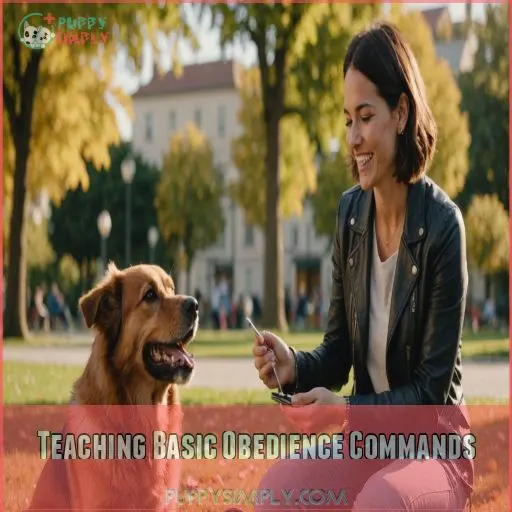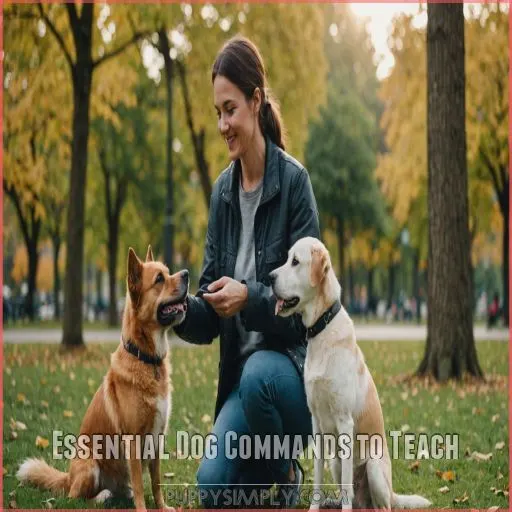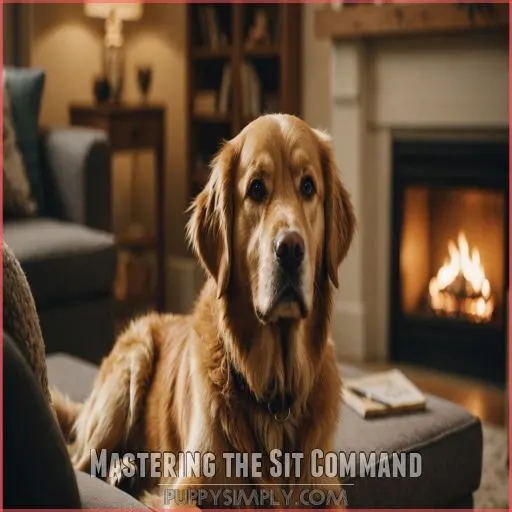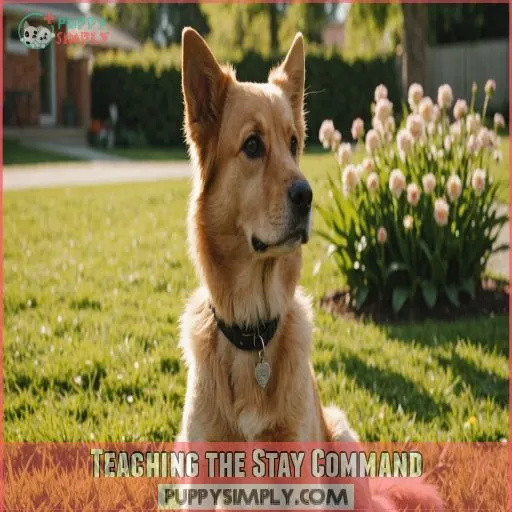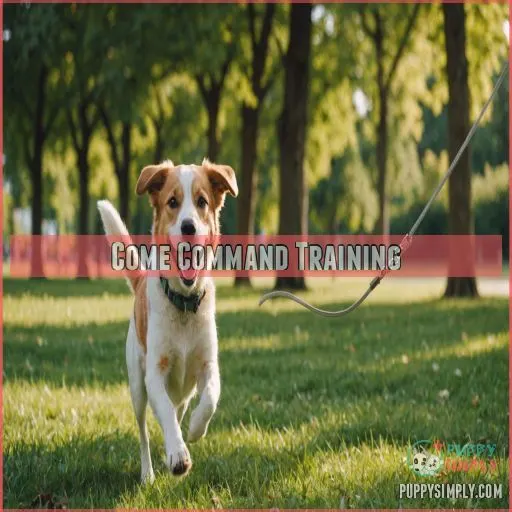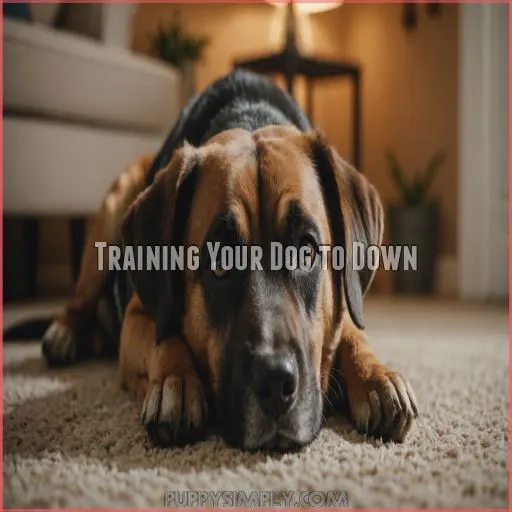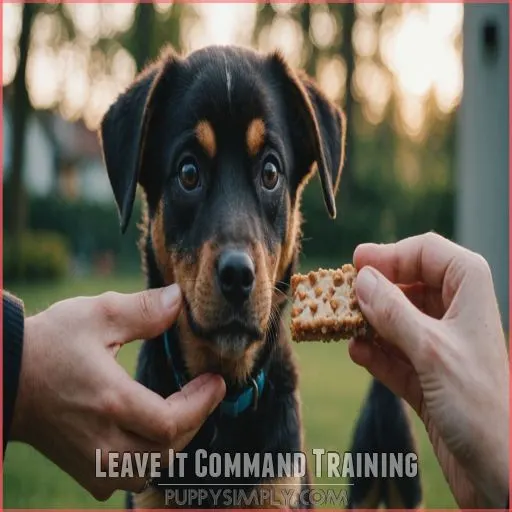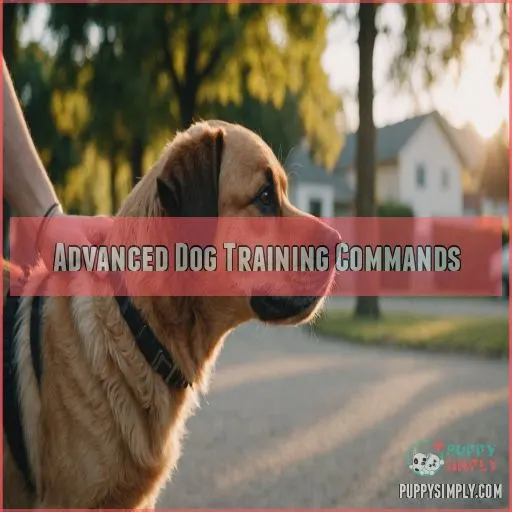This site is supported by our readers. We may earn a commission, at no cost to you, if you purchase through links.
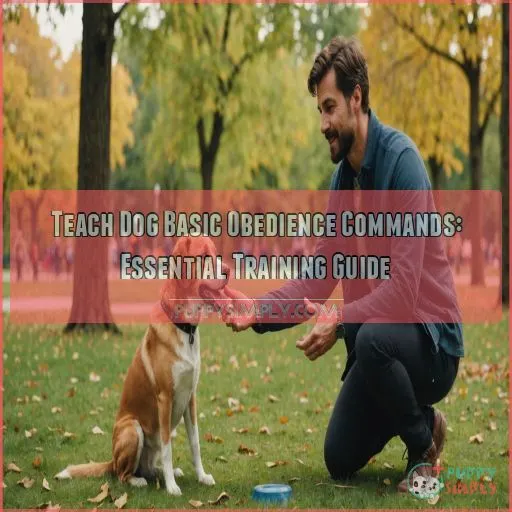
Start with essential commands like "Sit," "Stay," "Come," and "Down," using clear hand signals and consistent verbal cues to cut through any confusion.
Just like with people, some dogs are quick learners while others might need a bit more time—patience is your best friend here.
As you guide your pup, remember that training strengthens your bond, boosts their confidence, and keeps them safe—a trifecta of benefits!
Ready to wag your way to success? Stay tuned for pro tips to keep those tails wagging!
Table Of Contents
- Key Takeaways
- Teaching Basic Obedience Commands
- Getting Started With Dog Training
- Essential Dog Commands to Teach
- Mastering the Sit Command
- Teaching the Stay Command
- Come Command Training
- Training Your Dog to Down
- Leave It Command Training
- Advanced Dog Training Commands
- Overcoming Common Training Challenges
- Frequently Asked Questions (FAQs)
- What are the 7 commands for dog training?
- How do I teach my dog basic obedience?
- What are the top 10 commands to teach dog?
- What are the 5 obedience commands for dogs?
- How can I train a deaf dog effectively?
- Are choke, prong, or shock collars recommended?
- What is combination training for dogs?
- How do I socialize my puppy properly?
- What age should I start socializing my puppy?
- Conclusion
Key Takeaways
- Start with the essentials: Focus on teaching your furry friend the core commands like "sit," "stay," "come," and "down." These are the building blocks for a well-behaved pup and will make your life together much smoother. Remember, Rome wasn’t built in a day, and neither is a perfectly trained pooch!
- Consistency is your secret weapon: Use clear hand signals and verbal cues consistently, and stick to a regular training schedule. It’s like teaching your dog a new language – the more you practice together, the more fluent they’ll become. Before you know it, you’ll be having full conversations… well, almost!
- Positive reinforcement is your best friend: Reward your dog with treats, praise, and plenty of belly rubs when they get it right. It’s amazing how far a tasty morsel and an enthusiastic "good boy!" can go. Just don’t be surprised if your pup starts eyeing your dinner plate with newfound interest!
- Practice makes perfect (and patient): Gradually increase the difficulty of training sessions by adding distractions and practicing in different environments. Remember, every dog learns at their own pace, so stay patient and keep things fun. Soon enough, you’ll have a canine companion who’s the talk of the dog park!
Teaching Basic Obedience Commands
Mastering basic obedience commands is the foundation for a well-trained, well-behaved dog.
From the classic "sit" to the essential "come," these commands will help you and your pup communicate effectively.
These commands will also help you and your pup build a strong bond.
Common Dog Commands
Mastering your dog’s obedience transforms chaos into harmony.
Begin with essential commands: "sit," "stay," "come," and "down."
Picture it as teaching your dog fluent obedience—a life-saving language.
Use clear verbal commands and remember, consistency is key.
With positive reinforcement, patience, and these dog training tips, your furry friend will follow orders like a pro, freeing you both for bigger adventures .
Hand Signals for Dogs
Understanding basic dog commands enhances your bond with your furry friend.
Hand signals can really improve communication, especially if your dog responds better to visual cues.
- Benefits: Enhance training, reduce ambiguity, and aid dogs with hearing issues.
- Common Mistakes: Inconsistent signals, insufficient patience.
- Dog Breed Differences: Some breeds might learn quicker; tailor your approach accordingly.
Try incorporating these in your puppy training today!
Verbal Dog Commands
Switching gears from hand signals, let’s chat about verbal commands, really important in dog communication.
Use a clear, friendly voice tone for commands like "sit" or "stay," ensuring consistency.
It’s like teaching your dog the ABCs of obedience.
Keep it simple; practice makes perfect!
With patience and these dog training tips, you’ll have a well-behaved pup in no time.
Benefits of Basic Obedience Training
Dog obedience training is like giving your furry friend a backstage pass to the world! Here’s why:
- Safety First: A well-trained dog is less likely to dart into traffic.
- Confidence Boost: They feel secure making decisions with your guidance.
- Strong Bond: Training builds trust between you and Fido.
- Control and Communication: Say goodbye to chaos at home!
Getting Started With Dog Training
Getting started with dog training means setting the stage for success with a safe area, high-value treats, and a consistent schedule.
Think of it like preparing for a first date; you wouldn’t show up late or forget the chocolates!
Choosing a Safe Training Area
When you’re teaching basic obedience commands, selecting a safe training area is key.
Look for an enclosed space like a fenced yard or tennis court to minimize distractions and avoid unwanted escapades (Source).
Consider the weather and time of day—cool mornings often work best!
Dog-friendly areas can also offer new environments while keeping things engaging.
Selecting the Right Treats for Training
When selecting the right treats for your dog’s training, consider their size, texture, and flavor.
Opt for small, bite-sized pieces that are easy to chew and swallow quickly .
Vary the treat types to keep your pup engaged, and choose healthy, low-calorie options to avoid overfeeding .
The right treats can make all the difference in your training success!
Establishing a Consistent Training Schedule
Imagine dog training’s a dance, not a drill. Build a consistent schedule—like salsa, it needs rhythm but allows some hip-shaking freedom.
Training tips include regular sessions short yet punchy, prioritizing time commitment for their benefit.
Consistency benefits both of you, blending structure with spontaneity, turning training into a daily groove.
Embrace flexibility for a fun routine .
Preparing Your Dog for Training Sessions
Before kickstarting your dog’s training, focus on creating the perfect setup. Check these off your list:
- Pick the right Training Environment: Quiet spaces work best.
- Consider the Time of Day: Avoid when Fido’s sleepy.
- Gauge your Dog’s Energy Level: Not too high, not too low.
- Arm yourself with Treats and Rewards.
- Validate tips with dog training books and articles.
Essential Dog Commands to Teach
Teaching your dog essential commands like sit, stay, come, down, and leave it is a rewarding journey that strengthens your bond and adds fun to your daily routine.
Just imagine the joy and surprise on your guests’ faces when your dog sits politely—or at least stops stealing their snacks!
The Sit Command
Teaching your dog to sit is like giving them a magic button for calmness.
Start with a tasty treat and guide it over their head.
As they plop their butt down, praise them like they’re the next canine star!
Practice makes perfect, so keep at it.
Soon, you’ll both be enjoying the benefits of this essential command .
The Stay Command
Now that your dog can sit on command, it’s time to master "Stay".
Imagine teaching a dog to pause in the middle of a robbery movie scene.
Start small with these Stay command variations:
- Use clear hand signals.
- Gradually increase duration.
- Add distractions.
- Reward promptly.
- Troubleshoot any slip-ups.
Consistency makes your dog training sparkle!
The Come Command
To master the come command, entice your dog with treats while using a cheerful tone—it’s like inviting them to a party!
With consistency, even distractions won’t stop them.
Use a long leash for safe off-leash recall practice.
This essential dog training command boosts recall reliability, ensuring your furry friend returns from any distance, safeguarding their safety and freedom, especially when using a reliable leash.
The Down Command
With the "down" command, you’ll teach your pup to lie flat on the ground on cue. Start by luring them into the position with a treat , then pair the verbal cue "down" as they comply . Reward their efforts with praise and more treats. Soon, they’ll be dropping on command like a pro!
- Use a hand signal by lowering your hand in the direction of the ground
- Practice in different locations to generalize the command
- Avoid forcing them down, as that can backfire
The Leave It Command
Teaching the "Leave It" command empowers you, making a world of difference in your dog’s behavior.
It’s the Swiss army knife of dog training commands!
Starting with Leave it command variations, work on Leave it for food and toys for safety.
Practice Leave it in public with perseverance, guided by dog training ebooks and dog training mentors.
Success feels magical!
| Leave It Command | Starting Tip | Challenge |
|---|---|---|
| For Food | Use low-value treats first | Dogs get easily tempted |
| For Toys | Start with familiar toys | Higher excitement with squeaky toys |
| In Public | Leash training is essential | Distractions everywhere |
| General Safety | Consistent practice is key | Different environments test control |
Mastering the Sit Command
Teaching your dog to sit is like giving them their place at the family table—it’s a basic but essential skill that opens the door to further training.
Impressing guests in no time with just some simple hand signals, the right word at the right moment, and, of course, treats as irresistible as their puppy-dog eyes.
Using Hand Signals for the Sit Command
Start mastering the sit command by employing hand signals to teach your dog’s obedience.
Consistency is key.
Consider these steps:
- Hand signal variations: Use an open hand, palm up, moving upward .
- Timing: Deliver the signal right after grasping their attention.
- Alternatives to treats: Praise or play can be effective rewards.
Your faithful friend will soon sit happily!
Pairing the Word With the Action
When pairing the word with the action, timing is everything—say "sit" just before your dog performs the behavior.
Consistency is key; use the same tone and word each time.
With repetition, your dog will associate the cue with the action.
Imagine it like learning a dance routine: practice makes perfect, leading to a seamless performance .
Rewarding With Treats
Once Fido’s bottom hits the ground, immediately reward him with the right treat type.
Timing’s the name of the game in dog training—capture that precise moment!
Choose training treats that won’t break the calorie bank.
Switching things up with alternatives like verbal praise keeps dogs from becoming treat addicts.
Treat timing and frequency are key to mastering the sit command .
Gradually Fading Out the Treats
You’ve nailed rewarding with treats—congrats! Now, let’s talk about treat fading strategies.
Timing is everything; don’t cut treats cold turkey. Instead, mix it up by replacing some treats with praise or playtime.
If your dog seems puzzled, you’re moving too fast. Remember, treat fading challenges are normal, but patience is key for true training mastery .
Teaching the Stay Command
Teaching your pup the "stay" command takes patience, but the payoff is huge.
Start with short durations, reward for staying put, then gradually increase the time and add distractions – your dog will be a pro in no time!
Starting With Short Durations
You’ve nailed the sit command! Now, rock your dog’s world by teaching the stay command.
Start with short durations like brewing a pot of coffee.
Dogs dig consistency.
Here’s how:
- Say “stay” with your hand like a traffic cop.
- Increase the time gradually.
- Try different locations—home to park.
Barking up the right tree, aren’t you?.
Rewarding for Staying
Rewarding your dog for staying is key to their training success.
Timing’s everything—offer treats or praise immediately during the stay, ensuring your furry friend doesn’t miss the point .
Use a rewards schedule with treat alternatives like toys or cuddles.
Sprinkle positive reinforcement throughout dog training techniques, making each stay command feel like hitting the jackpot .
Increasing the Duration
As you continue rewarding your dog for staying, it’s time to increase the duration gradually.
Think of it like baking a cake—patience is key!
Start by adding a few seconds at a time.
Praise them for their patience, and remember consistency is your best friend.
Soon, your furry buddy will be a "stay" superstar in the dog training community!
Adding Distractions
Boost your dog’s self-control by adding distractions to their stay training.
Begin with small interruptions, like a toy or a family member entering the room.
Progressively increase these real-world distractions but maintain a focused training environment.
Humorously, think of it as a doggy boot camp!
With consistent practice and engagement, tackle any distraction management challenge with ease, giving your dog mastery over chaos.
Practicing in Different Environments
Where do you practice the stay command with your dog?
Start in familiar spots like home, then gradually move to busier places such as the park, store, or even the neighborhood street.
Introduce distractions slowly.
Remember, your pup’s success depends on your patience and a pocketful of treats—otherwise, it’s like trying to teach a squirrel to share its nuts!
Come Command Training
Training your dog to come when called is an essential skill that builds trust and keeps them safe.
With a cheerful voice, tasty treats, and lots of praise, you’ll have your furry friend bounding back to you in no time—like they’ve spotted the last slice of pizza on the counter!
Using a Happy Tone
Using a happy tone is like using a secret sauce in dog training—it turns the "Come" command into an irresistible invitation.
Your cheerful tone builds trust and draws your dog in.
Avoid sternness; instead, aim for musicality without being a broken record.
Dogs thrive on consistency and warmth, so let your tone be your training superpower .
Luring With Treats
Imagine this: you’re the pied piper with treats. Hold a delicious morsel near your dog’s nose like it’s a magnet, gently guiding them in your direction. This treat-based motivation harnesses lure-and-reward techniques, making it irresistible.
Remember, the secret sauce is treat timing and treat phasing. Slowly fade the lure, and voilà, you’re a dog-training maestro! .
Rewarding With Praise and Treats
Baiting with treats works wonders, but who doesn’t love a bit of praise?
Mix things up by giving your furry friend a hearty "good dog!" alongside treats.
Vary treat frequency to keep them on their paws!
If rewards become too predictable, motivation might slide.
Steer clear of overuse risks; a little mystery drives dog training associations home. (Source)
Using a Long Leash
Now that your pup knows treats are awesome, let’s talk long leash safety. A long leash offers freedom and control—like your dog’s golden ticket to explore.
Start leash training in quiet spots to minimize distractions.
Long leash benefits include practicing advanced commands like "Come!"
Remember, you’ll need steady hands; think gloves and comfy shoes.
Dog training’s no walk in the park! .
Training Your Dog to Down
Teaching your dog to go "down" is a fun and rewarding part of obedience training that builds their discipline and focus.
You’ll have them mastering the floor like a yoga guru before you know it!
Starting With a Hand Signal
Start teaching the "down" command with hand signals to capture your dog’s attention.
Use a firm but friendly finger point to the ground—like directing an orchestra of tricks.
Training consistency is your symphony, and these visual cues hit the right note in dog training partnerships .
Conjure up treats, engage their curiosity, and watch your pup excel!
Practicing in Different Positions
Once your pup has mastered the down command from a sitting position, start mixing it up!
Practice asking them to lie down from a standing stance or even while they’re walking.
This will solidify the behavior and make sure they respond to the cue no matter where they’re or what they’re doing.
Leave It Command Training
Teaching your dog the "Leave It" command is like showing them the secret to resisting temptation, and it’s easier than convincing a toddler to not touch anything in the candy aisle.
By mastering this skill, you’ll both enjoy more peaceful walks, knowing your pup can pass up questionable roadside snacks with grace.
Using Hand Signals
After mastering the "Down" command, it’s time to tackle the "Leave It" command with hand signals.
Hold a fist toward the ground or open your hand, signaling clarity and consistency for all breeds .
Timing’s key in dog training sectors; capture their attention precisely.
Consistent hand signals empower you, shaping the dog training market with your serene control.
Distracting With Toys or Treats
When training your dog to "leave it," keeping your dog motivated with the right distractions is key.
Balancing treat vs. toy options can transform a seemingly dull session into a thrilling dog training adventure.
Use high-value treats for timing rewards:
- Offer treats sparingly to maintain interest
- Rotate between toys and treats
- Create fun games to boost engagement
Remember, consistency is paramount for successful leave-it training.
Rewarding When Leaving It
Curious about the best way to reward your dog for mastering the "leave it" command?
Timing is everything!
Consistently mark the moment your dog resists temptation, then offer high-value treats or praise .
This consistent rewarding reinforces their choice and strengthens their impulse control, even amidst distractions.
Embrace these dog training principles, and you’ll soon have a well-disciplined furry friend!
Practicing in Different Situations
Getting that "leave it" command to stick in various scenarios is a dog’s day out!
Try it at a dog park or on a busy street; practice makes perfect.
Use it at home, during car rides, or when meeting new folks.
With patience and a touch of humor, you’ll be a dog training maestro in no time!
Advanced Dog Training Commands
As your dog masters basic commands, it’s time to tackle advanced skills like heeling and waiting.
You’ll feel like a magician (with treats as your wand) as you teach them to fetch your slippers on command!
Heel Command
The heel command is a really important skill for keeping your pup by your side.
Start by rewarding your dog when they walk alongside you, then add the "heel" cue and hand signal.
Gradually increase the duration and add distractions to reinforce the behavior.
Use treats strategically to keep your dog focused and engaged.
With patience and consistency, you’ll master the perfect heel!
Wait Command
Having aced the heel, let’s pause—literally!
The wait command isn’t just about patience; it’s a safety net.
Use it at doors, crosswalks, or even for fun anticipation games.
Get your dog to halt and say, "Hold your horses."
Start with a few seconds, gradually extending the wait.
Consistency and treats make it stick .
Release Command
When teaching the release command, timing’s everything!
Start by making your dog sit or stay, then use a release cue like "okay" or "break" with a clear gesture.
Your dog will gradually learn that waiting patiently leads to freedom—and treats!
Add humor: "Why do dogs obey? Because they see literally pawsitive rewards ahead!
Take It Command
You’ve mastered the Release Command; now it’s time to tackle the Take It Command. Encourage your pooch to safely grip objects with enthusiasm.
Use clear hand signals and make sure reward timing is spot on. Think of it as your dog’s diploma in household contributions.
Real-world applications abound, from fetching newspapers to snapping adorable photos. Let the tail-wagging begin!
Tricks and Advanced Commands
You’ve just mastered the command "Take It" and now you’re ready to move on to tricks and advanced commands.
Building on obedience, these skills will boost your dog’s confidence and agility.
- Teach "fetch" for mental and physical exercise .
- "Play dead" adds humor to training.
- Use "stop" for safety on walks .
- Master "speak" for alertness.
Overcoming Common Training Challenges
Training your dog can be as challenging as finding the missing sock in the laundry, but with patience and consistency, you’ll make progress.
Learn how to manage distractions and strengthen your bond with your furry friend to make obedience lessons stick.
Dealing With Distractions
Got a squirrel-obsessed pup? Handling distractions at home and outdoors is a challenge, but manageable!
Start with basics in a quiet spot, then gradually amp up outdoor challenges, like barking dogs or bustling parks.
Keep your dog’s focus with high-value treats, and remember: patience and consistency make perfect. It’s all about baby steps to mastering distractions!
Managing Training Sessions
Managing training sessions effectively is key to your dog’s success.
Keep sessions short, 5-10 minutes, to maintain focus.
Choose a quiet, distraction-free space to train.
Use high-value rewards to motivate your pup.
Most importantly, be consistent with your commands and training approach across all sessions.
With patience and practice, you’ll both master the basics.
Building a Strong Bond With Your Dog
Building a strong bond with your dog during training requires understanding dog communication and trust building.
Get into shared experiences like playtime; it’s where the magic happens!
Dogs thrive on consistency, so stick to your routine.
A sprinkle of humor doesn’t hurt—who knew your furry friend’s wiggly dance was actually revealing training secrets?
Let love and patience guide you .
Staying Patient and Consistent
Think of dog training like a marathon, not a sprint.
Challenges and plateaus can feel like hurdles, but consistency tips the scales.
Stay patient, using positive reinforcement and trust-building techniques.
Your dog, like a curious toddler, absorbs your energy.
Whether you’re knee-deep in "sit" or coaxing a "stay," remember: dogs learn through playful persistence.
Celebrate small wins!
Frequently Asked Questions (FAQs)
What are the 7 commands for dog training?
Did you know 7% of dog owners don’t train their pups?
Change that by teaching your dog these essential commands: Sit, Stay, Come, Down, Heel, Leave it, and Stop.
These build trust and make sure safety.
How do I teach my dog basic obedience?
Start with consistency and positive reinforcement.
Teach commands like "sit," "stay," and "come" using treats and praise.
Practice daily for short sessions.
Stay patient, and you’ll have a well-trained companion happy to impress! .
What are the top 10 commands to teach dog?
Help your pup reach their full potential with the top 10 commands: "Come," "Sit," "Down," "Stay," "Heel," "Leave It," "Drop It," "Fetch," "Speak," and "Roll Over."
Mastering these will make your canine companion a well-behaved, obedient, and joyful companion.
What are the 5 obedience commands for dogs?
Teaching your dog the five key commands—sit, stay, come, lay down, and drop it—boosts their obedience and enhances your bond.
With consistency and praise, you’ll transform your pup into a well-mannered companion .
How can I train a deaf dog effectively?
Did you know dogs can understand over 100 hand gestures?
Communicate with your deaf dog through consistent hand signals and rewards.
Experiment with basic ASL signs and use a vibrating collar to get their attention .
Are choke, prong, or shock collars recommended?
Avoid choke, prong, and shock collars for a more positive approach!
These harsh tools can cause anxiety and physical harm.
Instead, opt for reward-based methods or comfy harnesses that promote trust and happiness for your furry friend .
What is combination training for dogs?
Combination training for dogs blends various methods, like operant conditioning and clicker training.
It’s about balancing positive reinforcement with other strategies for a harmonious, well-behaved companion .
How do I socialize my puppy properly?
Take your puppy on safe adventures to meet new people, sounds, and dogs post-vaccinations.
Keep experiences positive with treats and calm praise.
Introduce new things gradually; every wag and sniff is a pawsome step toward bravery .
What age should I start socializing my puppy?
In a jiffy, start socializing your puppy by 8 weeks old.
This early phase sets their course, ensuring they’re confident and well-adjusted in new experiences by 16 weeks.
It’s really important for lifelong harmony (Source).
Conclusion
Congratulations, you’ve mastered the art of teaching your pup basic obedience commands!
Now, the real fun begins. Explore your creativity and teach your canine companion some fancy tricks.
Who knows, you might just have the next Lassie on your hands.
Remember, with patience and consistency, you can teach an old dog new tricks – or in this case, teach your furry friend the essential commands to keep them safe and happy.
Happy training, dog lovers!

